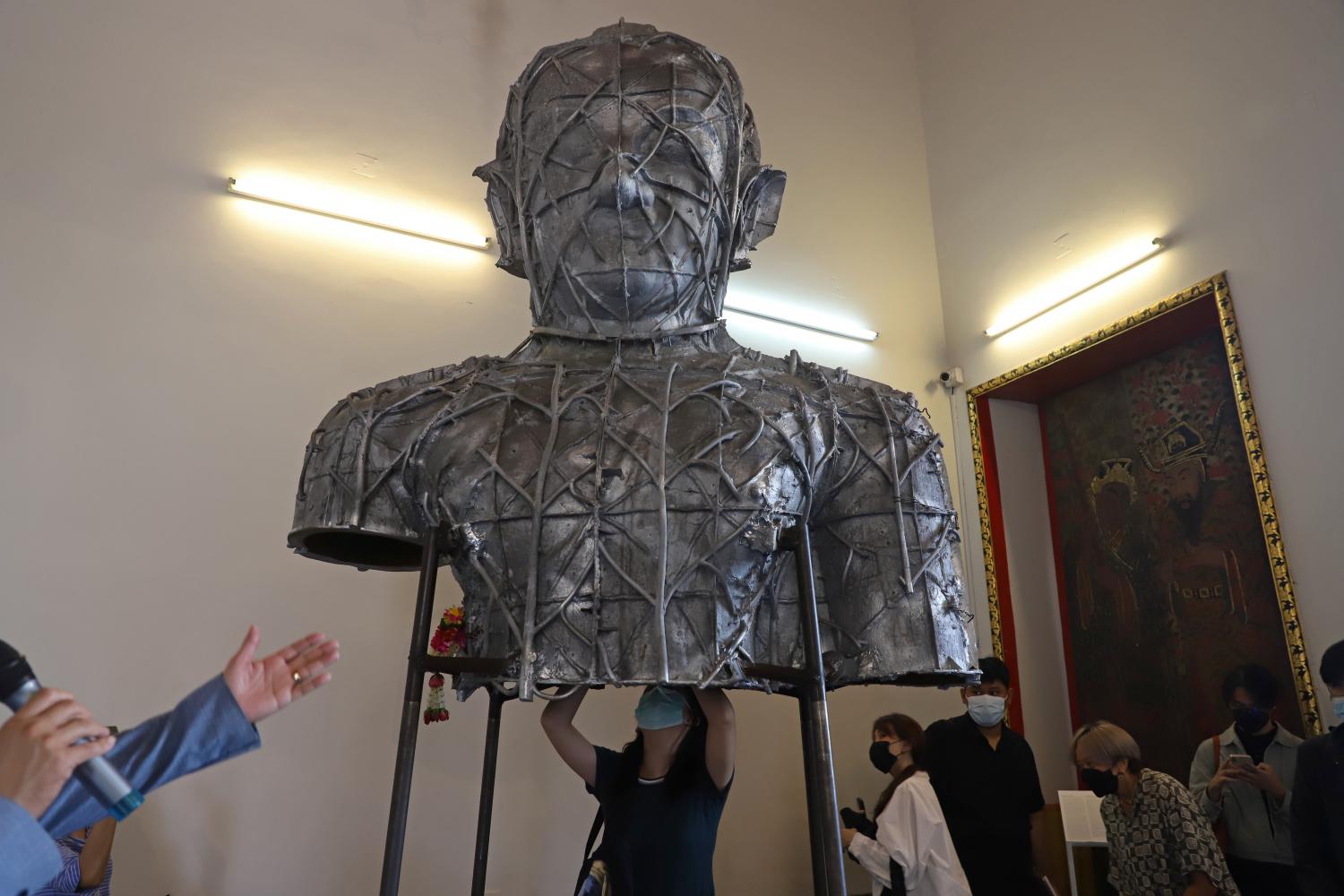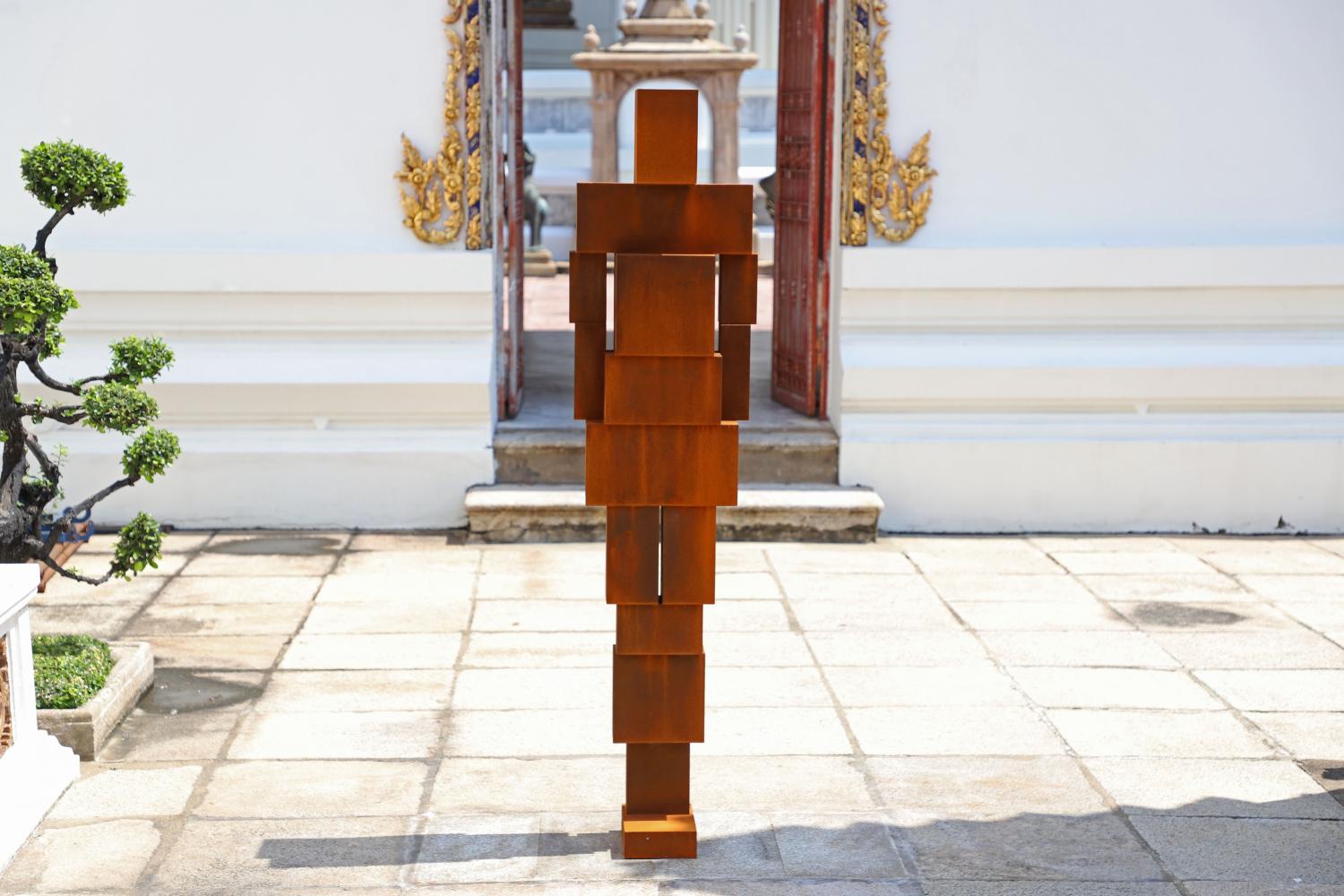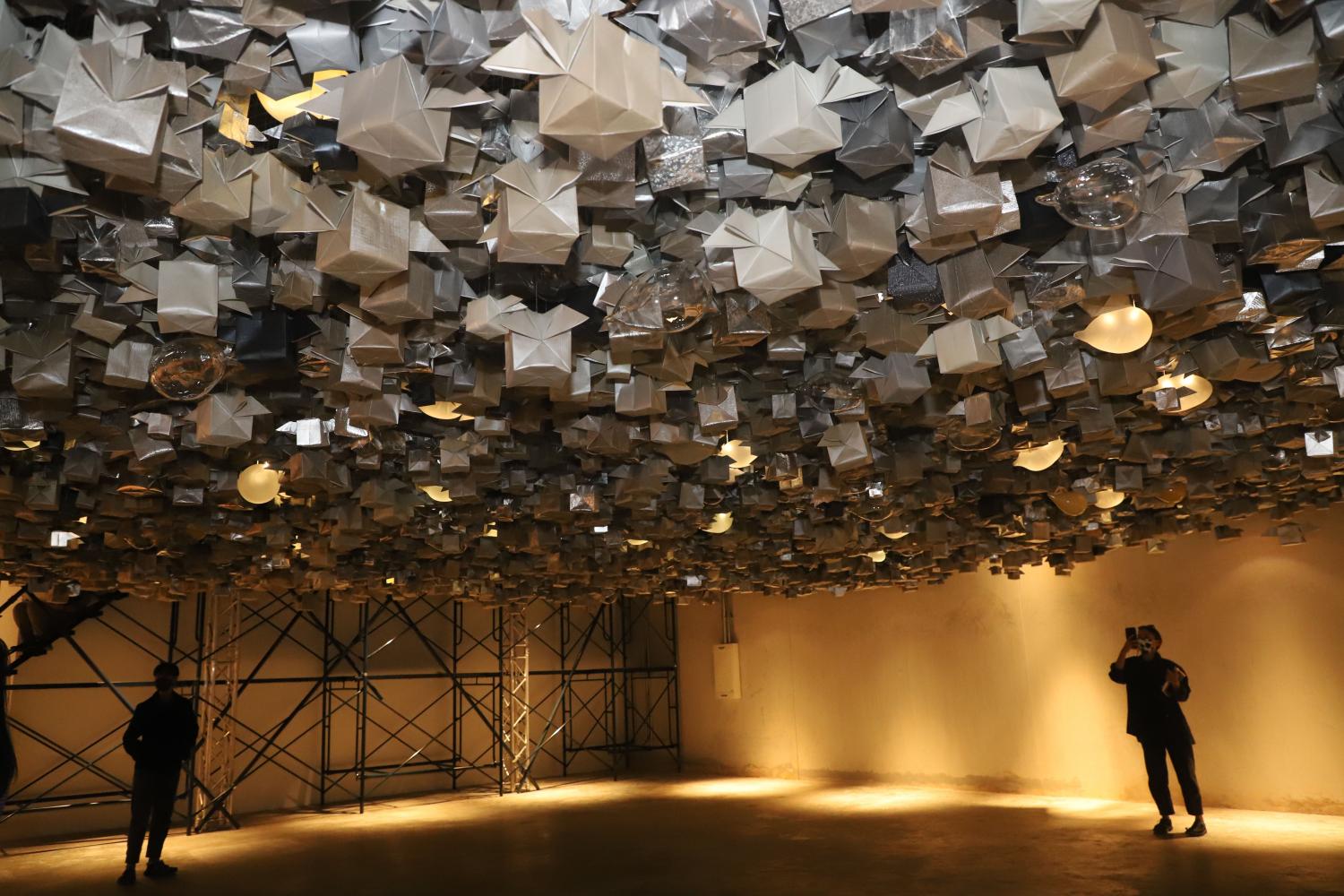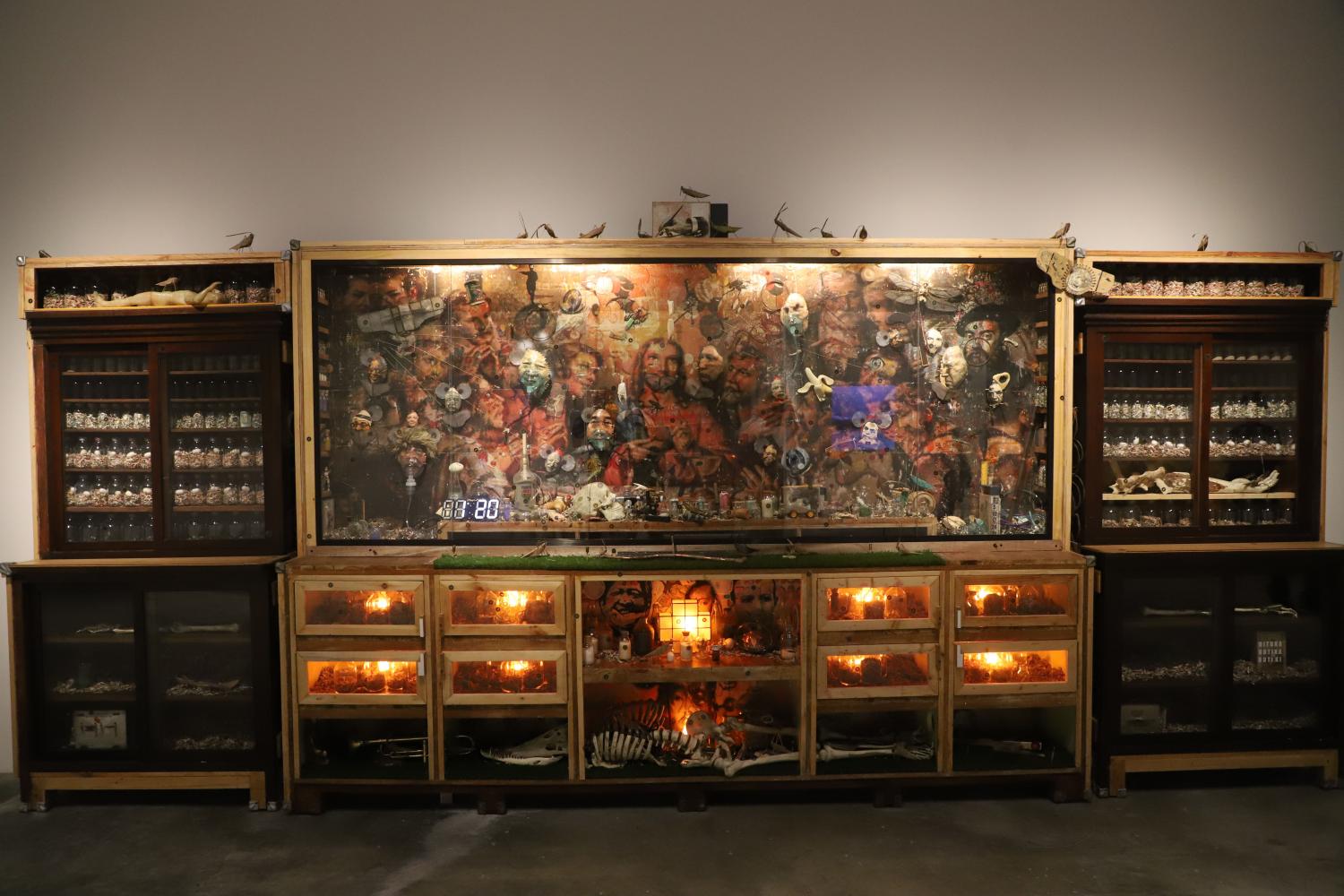The third edition of Bangkok Art Biennale 2022 (BAB 2022) with its theme "Chaos: Calm" reflects obstacles that mankind encountered during the Covid-19 pandemic. Both chaos and calm are temporary states that are interchangeable according to situations and conditions.
From now until Feb 23, the BAB 2022 showcases over 200 pieces by 73 artists from 35 countries at 12 venues. Main venues include Museum Siam, Wat Pho, Bangkok Art & Culture Centre (BACC), Queen Sirikit National Convention Center (QSNCC), JWD Art Space and CentralWorld. On a press tour to Wat Pho, Museum Siam, BACC and QSNCC, Prof Apinan Poshyananda, chief executive and artistic director of Bangkok Art Biennale, provided information of the artists' backgrounds, their inspirations and interpretations of their artworks.
Wat Pho is a key venue where tourists can experience both cultural heritage and contemporary art. Two art installations -- Arokhayasala and Melting Void: Molds For The Mind -- created by the late Thai artist Montien Boonma are showcased in Wat Pho. Located in a Chinese style building, Arokhayasala, which was inspired by the shape of lungs, is displayed to the public for the first time. Arokhayasala, which consists of brass plates, bronze and stones, was created in 1994 when Montien's pregnant wife was diagnosed with breast cancer. The installation expressed his need for healing and communicating with his wife's spirit. Situated next to Pa Lay Lai Buddha statue, Melting Void resembles a Buddha statue. With its huge size, visitors can step into the installation and feel at peace there.
British artist Antony Gormley designed two site-specific sculptures made of cast iron -- Contain and Connect -- to display in Wat Pho. The sculptures look like human figures, which possibly represent international visitors to Thailand.

Melting Void: Molds For The Mind by Montien Boonma.
At Museum Siam, Japanese artist Tatsuo Miyajima presents Wall Of Change, which is a project in which five digital numbers are drilled into a wall. The five numbers are changed every day according to the digits zero-to-nine on a 10-sided dice. In the past, Miyajima had never used the digit zero in his work because it symbolises death, while other numbers symbolise life. However, after people went through the pandemic, Wall Of Change now includes the digit zero.
While many people find cockroaches unappealing, Tazeen Qayyum, a Pakistani-Canadian multidisciplinary artist, uses the insect as an inspiration to create beautiful site-specific installations and the sculpture Patterns Of Resilience. Due to their strong resilience, cockroaches can survive in the worst of conditions. Mounted on the walls of the exhibition, Patterns Of Resilience reminds people that their survival through the pandemic depends on coming together and building community.

When The Fish Is Chirping by Arin Rungjang.
At the BACC, a group of artists from Chiang Mai and Chiang Rai called Art for Air displays graffiti, paintings, a film and other installations to raise awareness and question issues regarding the PM2.5 air pollution in the North. It has been known that people in the North suffer from PM2.5 air pollution every year, but this problem has never been solved. On one side of a wall, many artists used grey spray paint to illustrate pictures of a girl, a corncob, animals, factory smog and public transportation in the smog.
Phitchapha Wangprasertkul, an art performer, said research and information have influence on people. In the past, eight hours of sleep was enough, but recently, people were told two separate periods of four-hours sleep is sufficient. Within eight years, the standard size of a one-bed living unit has been reduced from 65m² to 28m². At BAB 2022, Phitchapha decided to conduct an experiment, The Standard, whereby he spends time working in a small transparent box from Tuesday to Friday for eight hours a day. The experiment questions capitalism and the quality of life for office workers.
Arin Rungjang, a pioneer of installation art in Thailand, displays a video series, When The Fish Is Chirping, which features interviews with young people who express how they feel about their motherland. Next to the video screens, there is a sculpture in a form of a Mobius strip. The sculpture represents an infinite loop that implies that young people will encounter no way out of existing problems created by the previous generations. Many electronic chips are attached to the sculpture to embody electronic waste. E-waste is one of the environmental issues that is not managed properly.

Contain by Antony Gormley at Wat Pho.
Udomsak Krisanamis is best known for his distinct collage technique experimenting with everyday objects and materials including newsprint, cartons, maps and paint. The mixed media on canvas The Whole She Bang and Clear The Air depict lines of white circles on a black background. In addition to his mixed media work, Udomsak encourages viewers to play ping pong in BACC. He explained that a similar characteristic of art and sports is that they both require concentration. His circle images and the round shape of a ping pong ball symbolise a goal; people must focus to reach their goals.
QSNCC, which reopened in September after a three-year renovation closure, is a venue that art enthusiasts should not miss because of the many impressive artworks on display.
Pinaree Sanpitak, who is notable as one of Southeast Asia's most important contemporary artists, presents Temporary Insanity and Anything Can Break. These two installations are interactive experiments about the human body and the sensory system. Temporary Insanity features hundreds of brightly-coloured, interactive soft sculptures that hide an audio machine that responds directly to the movements and sounds of viewers entering the installation area. Meanwhile, Anything Can Break is an intriguing installation hanging from the ceiling which features "flying" origami cubes and hand-blown glass figures. This interactive installation responds to the physical presence of the audience through motion sensors that trigger soundscapes. When Anything Can Break was launched in 2011, visually impaired students came to experience sounds of the installation.

Wall Of Change by Tatsuo Miyajima.
Based in Australia and the Philippines, Alwin Reamillo presents his local belief and criticises colonialism as well as powers of politicians through his installation Apotekariya Cena Semana Santa Cruxtation II Or How To Intone Butiki, Bituka, Botika. The installation looks like a display cabinet that features a picture that resembles the The Last Supper. However, the faces of Jesus and his disciples are replaced with faces of politicians such as the US President Joe Biden, Chinese President Xi Jinping, Thailand's Prime Minister Prayut Chan-o-cha and Deputy Prime Minister Prawit Wongsuwon, as well as Ferdinand Magellan, the Portuguese explorer who discovered the Philippines.
- Bangkok Art Biennale 2022 runs at 12 locations until Feb 23. Free admission.
- For more information, visit bkkartbiennale.com and facebook.com/bkkartbiennale.

Temporary Insanity by Pinaree Sanpitak.

Anything Can Break by Pinaree Sanpitak.

Apotekariya Cena Semana Santa Cruxtation II Or How To Intone Butiki, Bituka, Botika by Alwin Reamillo.

Patterns Of Resilience by Tazeen Qayyum.

